It was a lonely stretch of New Mexico state road where I left the car that late summer day in 1981. Not a cloud in the deep brilliant blue sky. Making my way to the barbed wire fence, with great difficulty I shoved my heavy backpack over, then crawled under the fence onto BLM land. The powerful presence of Bear Mountain loomed above me, but I took a deep breath before I set out to ascend this singular volcanic dome north of Tres Piedras near the Colorado border.
This was my first journey in a quest to climb the four mountains I understood were significant to Indigenous Pueblo people in the region, each holding the energy and powerful meaning of the cardinal directions. A newly arrived to New Mexico from my home state Colorado, I was using the climb to honor the ancient cultures of my new home and perhaps discover some inspiration along the way. But I had no idea what really was in store for my mysterious night alone on the mountain.Helping me maneuver through the tumble of black volcanic boulders with a 40-pound backpack was a walking stick hand carved by Great Grandpa William McKenzie, made over a hundred years ago from a cholla cactus. He also made hard wood walking sticks which he sent to the United States presidents on their inaugurations. Benjamin Harrison’s hand written thank you letter hangs next to the secretary desk Grandpa crafted from the walnut trees on his farm. One time while visiting my maternal grandparents on their farmhouse built by my venerable ancestor, I spied the cholla walking stick leaning against a corner of the buckling linoleum floored dining room. It was half hidden next to the 100-year-old glass windows that had their own aged buckling and bubbles. I think it was waiting for me for the right time and Grandma Fleming gave permission for me to take it home. The cane became a talisman of my own ancestry and culture. In a way, that walking stick I carried up the mountains also carried me as a direct and tangible link to my family history.
Of all the ethnic family strands, it’s the McKenzie Klan of the Scottish Highlands with whom I feel closest kinship. In the only real picture I have of him, grandpa has a serious countenance and a full white beard that extends to the middle of his chest. I don’t know if he had a sense of humor, but he had a sense of purpose that I like. I imagine him to be a bit dour and highly principled with a sense of responsibility to family and community. He was a decorated Civil War veteran for the Union and a leader. Who knows? Maybe he had a secret life as a fancy dancer! Years ago, my mother gave me his “Gunn’s Family Physician,” a thick tome of the time on health and healing for body mind and spirit. I have traced his hand written notes with my own hand and use the book as a reference for health matters. Just so happens I became a massage therapist and have an ongoing interest in preventive health care. Feels like a lot of Grandpa McKenzie lives on in me.
The first thing I moved into my Santa Fe home where I’ve lived for over 20 years at this writing, was an eight-foot-tall secretary desk grandpa crafted from walnut trees on his farm. He built two large houses mostly by himself, and the desk gives me a sense of continuity, confidence and practical skills, like taking steps up a tall ladder with someone securely holding it in place at the bottom. When refinishing the desk, my father found a picture of Abraham Lincoln, President at the time, pasted onto the desk. Every time I dust that desk, I touch the past and shake hands with my family. One aspect of history not mentioned, though, is that like most places in this country, grandpa’s farm and the trees he fashioned into homes were on Indigenous land that was originally taken by hook or by crook. Whether grandpa ever acknowledged this or offered his respect is lost to history. Even President Lincoln, honored in so many ways, was sadly responsible for the forced removal of Indigenous Americans from their homes and turned a blind eye to horrific treatment of Native people. https://www.history.com/news/abraham-lincoln-native-americans

McKenzie Klan Emblem
The path up the 2,000-foot Bear Mountain (called San Antonio on the map) was non-existent. I laboriously traversed up sharp-edged basalt, loose boulders, rubble and vertical terrain. It was slow, arduous going and early on I got tired and frustrated with a heavy pack on my back. Halfway up I noticed a huge black bank of thunderstorm clouds fast approaching from the west. The wind picked up and I started to worry about being caught on the mountainside in rain and lightning. I increased my pace and also increased my level of impatience at the slow going which was much slower than that of the oncoming storm. As the wind whipped more fiercely, I lashed out with the cane at plants and objects “in my way.” Some part of my mind was well aware that I should not be using grandpa’s walking stick in such an angry way.
Finally, I made my way through the scrub oak and Ponderosa pines to Douglas fir and shimmering aspens at the top of the mountain. Quickly making camp and setting up the tent, I waited for the big storm–which never arrived. All that fussing and furious fuming for nothing. It struck me as ironic that our McKenzie Klan emblem, flames shooting from the top of a mountain, mirrored my emotions at the time, because I’d been burning up with impatience on the difficult ascent. Here I was on top of a mountain that millions of years ago was molten red hot, no doubt with flames shooting out in every direction. If I had only remembered the McKenzie Klan motto: “I shine not burn,” (Luceo Non Uro) I might have taken a breath, paused and continued at a more reasonable pace.
I set up the tent and made camp for the night. But later in the darkness I awakened to sounds of footsteps and was frozen with anxiety. It seemed like a two footed being, but I was not sure. Bear? Deer? Cougar? Human? Slowly the footsteps circled the tent with me inside not knowing what the next step might bring. Silently I heaved a sigh of relief as the next steps were away from the tent until I could no longer hear them.
In the morning when I packed to leave, Grandpa McKenzie’s walking stick was nowhere to be found. Could it somehow have been taken out of my hands for misusing it when I was angrily hacking at plants in my way on the furious ascent? Was it the mysterious being in the night that took it away? Whatever. Sadly, and slowly, I loaded up the backpack and walked away from the site for the return home. But then there was a voice in my mind. Where do these things come from in our head, these unbidden words seemingly out of nowhere like a telemarketer on the phone or an unsolicited email? Quièn sabes, but the voice was there, telling me to “Remember to thank the place where you have been!” Following this good advice, I turned around to do so and there, on the ground at my feet–the walking stick! Funny thing though. Years later I discovered that I could have easily driven my car on a gravel road nearly to the top of the mountain. I am glad I didn’t.
Roshi Joan Halifax in her book “The Fruitful Darkness: A Journey Through Buddhist Practice and Tribal Wisdom” (Grove Press; 1st Grove Press Ed edition (March 15, 2004) relates a question she asked of Zentatsu Richard Baker: “Roshi,” she asked, “there is the path to the temple and there is the temple. What is the meaning of the path?” His answer: “Joan, the path IS the temple.” I get that. Without my emotional and physical struggle up Bear Mountain I might not have been given the teaching on the summit. Now, for me the cardinal direction of the north is where I remember my ancestors, especially Grandpa McKenzie. And the teaching? To always thank the people and places I live and visit in life’s journey–my individual earth walk. And another message from the mountain: “to shine not burn.”
Maybe that’s a message trying its best to get through to me all my life. I have this distinct memory from about age six of being in my parents’ basement on Krameria Street in Denver, sitting in the dark and lighting a candle. The memory literally burned itself into my mind when like a moth drawn to the flame my little self-bent forward too closely, staring into the flickering luminosity and singed my eyebrows. Guess I could have singed more than that since my older brother Gary now tells me that his bedroom was in the basement.
As I grew older, the little moth of my mind kept fluttering towards the light, sometimes nearly consumed in the flames. In my hippie days in undergraduate school, we’d usually light a candle as part of the ritual involving the illicit cannabis. One of my close friends during these flights of fancy said she thought lighting a candle was like letting a little bit of God in the room. That stuck, though the use of cannabis did not.
It was the Vietnam War era in the late 1960s and I was feeling schizophrenic. Maybe not clinically, but one day I was dressed in ROTC military uniform, marching on the college playing fields, trying to act like a little soldier. The next day, I was marching in the streets against the war. What was wrong with this picture? Then came officers’ basic summer camp in 1970 at Ft. Sill, Oklahoma. At the beginning of training, we were warned repeatedly, “Don’t touch the barrel of the weapon you have been using. It will burn your hand.” Good advice, but what I call my “angel guides” had me do exactly that, so I did indeed burn my hand severely and couldn’t train with a weapon for a while. Another one of those unbidden messages telling me to seriously consider what the heck I was doing.
I actually don’t remember much else about summer camp, probably because I want to blot out that distressing time in my life. My senior year in college I went through agonizing soul searching, counseling, lots of lit candles, the news about National Guard killing of anti-war student protesters at Kent State University in Ohio and the My Lai massacre of Vietnamese civilians by US soldiers. My final decision was to “shine and not burn” in this terribly wrong military conflict. I applied successfully for noncombatant status, which meant I was denied the officer’s commission and subjected to the draft. Ultimately, I was drafted and served two years in the Medical Service Corps, facing some hellish situations. But that’s another story.
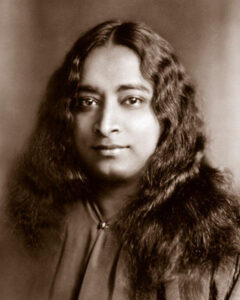 In later years I discovered the teachings of a wise East Indian avatar, Paramahansa Yogananda. In a book called “Man’s Eternal Quest” he wrote:
In later years I discovered the teachings of a wise East Indian avatar, Paramahansa Yogananda. In a book called “Man’s Eternal Quest” he wrote:
…You cannot make steel until you have made the iron white-hot in the fire. It is not meant for harm. Troubles and disease have a lesson for us. Our painful experiences are not meant to destroy us, but to burn out our dross, to hurry us back Home. No one is more anxious for our release than God.
After the Army I headed back to my hometown of Denver, Colorado. But fire seemed to follow me wherever I went, or maybe I followed it. One surprise birthday party at a friend’s home, I got the call that the fire department was scraping the remains out the window of my rental home in the Cherry Creek area. Faulty wiring had shorted out an electric blanket on my bed. One good thing about the fire though: the gold polyester wide lapel leisure suit my parents had given me melted. I never did like that goofy looking thing.
Work and graduate studies at the University of Colorado took me to Boulder. That went pretty well but the green bubble of Boulder was surrounded by the front range “brown cloud” air pollution in the Denver area. It was a dry summer and thick smoke from fires in the foothills added to the poor air quality. I thought I had returned to my hometown after the Army, but it had been swallowed up by rampant urban growth we humorously called “Californication.” I felt pushed out of the area, but I also felt a pull to New Mexico.
So, Mona my cat and I packed up and moved to Santa Fe in 1978 and after several years found a wonderful old crumbling adobe duplex rental on Upper Canyon Road that at one time had been in the hands of the first Santa Fe Archbishop, a Frenchman named Lamy. But unwelcome fire continued to follow me. One day I came home to find the foam rubber plug to my fireplace melted and a large pillow sitting in front of it on slow burn, headed to the 150-year-old wooden plank floor. Years later when I was teaching my “Earth Walks: The Spirit of Place” class at Ghost Ranch Education and Retreat Center north of Santa Fe, I came into my classroom to find the fireplace mantel smoldering, somehow lit from my incense sticks. Hmmmmm….was there a pattern going on here? Burning, not shining like the McKenzie Klan motto advises.
It wasn’t all hell fire and brimstone, though. Along the way I started picking up clues to fire being a way to burn out my “dross” and help me hurry back “home.” Sunday night fires in the Ben Franklin stove had been a family tradition growing up, along with popcorn and hot chocolate, us boys polishing shoes for the school week ahead and watching our favorite TV shows–Gary Moore, I’ve Got a Secret, Gunsmoke and Bonanza, To Tell the Truth, the Carol Burnett Show…and all the rest.
Now in New Mexico, Sunday nights have become my own tradition. Popcorn and hot chocolate for sure, but no more shoe polishing. The longer I lived in Santa Fe the more I found fire to be an essential element of my consciousness. The McKenzie Klan symbol is “fire on the mountain,” but there haven’t been volcanoes in Scotland for millions of years. Near Santa Fe, however, is a recently active region of big-time eruptions and magma flows. The largest man made “fire”–the atomic bomb–was developed just 30 miles away and tested in the southern part of the state. Talk about the need to “shine, not burn!”
Along the way in Santa Fe, I met Concha Garcia Allen, elder member of the Mexican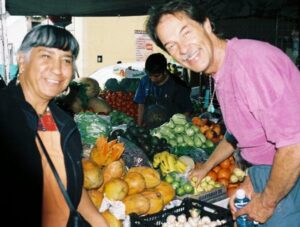 Danza Azteca ceremonial prayer group. She introduced me to “Tatewari” or Grandfather Fire in the native Huichol tradition. Tatewari represents–actually becomes–a breathing, speaking elemental force which empowers a person to follow her heart path to completion. For me this age-old shamanic practice made complete sense as I began to weave the threads of my own Scottish highland Fire Klan heritage. On Earth Walk journeys in Canyon de Chelly, Dinè guide Daniel also spoke with Tatewari, although by another name, in the embers of our campfire divining meaning and messages for those willing to listen.
Danza Azteca ceremonial prayer group. She introduced me to “Tatewari” or Grandfather Fire in the native Huichol tradition. Tatewari represents–actually becomes–a breathing, speaking elemental force which empowers a person to follow her heart path to completion. For me this age-old shamanic practice made complete sense as I began to weave the threads of my own Scottish highland Fire Klan heritage. On Earth Walk journeys in Canyon de Chelly, Dinè guide Daniel also spoke with Tatewari, although by another name, in the embers of our campfire divining meaning and messages for those willing to listen.
In 1993 leading a small group of people to Oaxaca, Mexico for Dia de los Muertos (Day of the Dead) I discovered the ancient Mexican god of the fire and brought a weaving of the image back home where it hangs above my bed in all its fiery composure. That same year I traveled to the home of Annie Kahn, Dinè elder and teacher, for a visit and sweat lodge. Sadly, the lodge had been burned down by arsonists just prior to our arrival. Annie sent family members into the nearby mountains to gather the proper plant materials to do ceremony and prayer. As soon as possible, we all pitched in to help rebuild the sweat. This, Annie said, was essential.
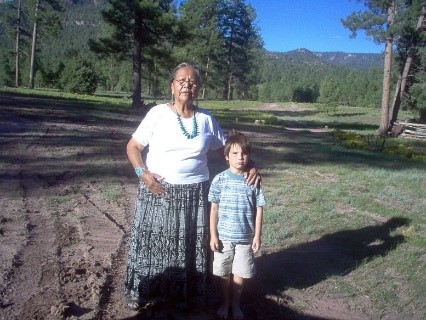
Annie Kahn
“Never let something bad happen without making it right as soon as you can,” she explained. “Don’t let the bad thing fester.” That was good advice to me who tends to perseverate and stew over sometimes the smallest things.
Ten years later in 2005 and half a world away, I was floating in a boat on the sacred Ganges River fascinated by flames of the Indian Hindu “Aarti” ceremony. It was night and the waters of the great river in front of us reflected and intensified what we saw on the shore. Brahman priests clad in saffron colored robes chanted continuously, circling multi-tiered butter lamps in great arcs around their heads, ringing bells and chimes and intoning ancient prayers. It had been this way for centuries and though my traveling companions and I were tourists, the power of the ceremony was anciently familiar in my Scottish Fire Klan bones.
This was not the only flame I saw while in India. Days later our group visited Bodh Gaya, the site where it is said that Siddhartha Gautama, the spiritual teacher who later became known as the Buddha, is said to have attained enlightenment. An offshoot of the original venerable “peepal” or fig tree under which he attained this state of consciousness now grows next to the large temple erected in his honor. https://en.wikipedia.org/wiki/Bodhi_Tree
As I knelt at the steps in front of the tree and bowed to honor the Buddha, my head bonked on the stones so hard that I thought it must have been audible to those around me. Immediately amidst the ringing in my ears I heard in a loud exclamation: “Awaken!” Funny thing, one of our tour leaders, Annette, told me later she had the same exact experience. I wonder what spiritual Youtube channel we both were plugged into?
Returning to the scene of the head bonk that evening, thousands of pilgrims were circumnavigating the temple, prostrating themselves on the sidewalk every few feet. Over the loudspeakers a continuous droning chant was taking place. But I found the low bass tones irritating and was hoping the group of younger monks in front of me were next in line to chant, hopefully with a more baritone. I sat opposite the group, taking it all in—the crush of the crowd, the droning basses, the intense spiritual fervor and me, just sitting there quietly watching. For a moment there was a parting of the crowd and gazing across at the seated group of monks, I was astonished at what I saw: a large flame inexplicably suspended in midair above them. The crowd crushed in again, then again briefly parted. The flame was gone.
But not gone from my consciousness. The flame was as real as the nose on my face and blazed its image into my mind. I had to find out what it meant. Once back in New Mexico, my search uncovered a rich and complex symbolism for the flame across cultures and traditions. The Christian view sums it up for me: the Holy Spirit. Kinda gives a new light–so to speak–on popcorn, hot chocolate and my Sunday night winter fires. I keep lighting those fires and also lighting a single candle each evening that glows throughout the night. It’s a way to remember the message of Bear Mountain and the counsel of my McKenzie Klan to “shine not burn” as I continue on my earth walk this lifetime. (For worldwide meaning of the sacred flame: https://www.ancient-origins.net/myths-legends/fire-symbolism-flames-ignite-faiths-and-inspire-minds-004404 From this website, the following picture.)
We are the weavers, we are the web
We are the flow, we are the ebb
—Shekkinah Mountainwater
She hid herself as quickly as she could. The hulking figure was walking directly towards her and she knew what had happened to so many others of her family in a similar situation–a horrible death. Crouching in the shadows she waited for what was to come next. But in her wildest imagination, she could not have guessed what did come next.
“It’s OK, I’m not going to hurt you. You can come out,” I said quietly as I gently knocked on the window frame where the spider had hidden when she saw me walking towards her.
To tell the truth, I was lonely. Coming from a middle-class family, I was finding it hard to relate to the uber wealthy students at the University of Denver where I attended in 1971. They stepped out of their Lamborghinis with designer jeans that cost more due to the intentional holes in the knees. I stepped down from a used VW bus to get to my clerical work study job at the history department office.
This particular night in my basement apartment I felt especially lonely. When I spied a spider on the wall near the window, I thought, “Maybe here’s someone I can talk with.”
Little did I know how right I was.
As I walked towards the spider, she saw me too and quickly retreated under the window frame, fearing the worst. Many people smash spiders when they are in their home, maybe out of fear of the unfamiliar, unknown—the “other.” With some, their fear gets out of hand and they feel uneasy in any area they believe could harbor spiders or might have a web. Some people scream, cry, have emotional outbursts, experience trouble breathing or go into panic attacks. We’re talking extreme arachnophobia, and in some cases, even a realistic picture or drawing of a spider can trigger intense anxiety.
“It’s OK, I’m not going to hurt you,” I repeated to my little hidden arachnid.
Well, if I haven’t lost you at this point, perhaps you’ll believe what happened next: First one little leg emerged, then another and another until she was fully out on the wall. “Hungry,” came to my mind. I searched the nearly empty college student fridge, brought back yoghurt and put a drop of it on the wall—which the spider moved up to and ate. A few days later, she traveled on.
I traveled on, too, was drafted out of graduate school into the Army during the latter days of the Vietnam War, went back to Denver after my discharge, entered graduate school at the University of Colorado and eventually moved to Santa Fe, New Mexico from Boulder. One day, in 1980 in the Chupadero Valley north of Santa Fe where I was living, I felt I was being watched while showering. Looking up, I noticed a black spider had come out of the plumbing. I wasn’t too concerned as she was busy working on her web and enjoying a bit of steam bath at the same time. This went on for months until spring solstice 1981 when I sadly found her lifeless body belly up on the shower floor. And as I suspected, there was an orange hourglass on that belly. A Black Widow spider.
Spiders kept showing up around me. In 1984 at the Hopi Mesas of Arizona I was helping guide a tour for the Wheelwright Museum of Santa Fe as the new director of public information. Waiting for the tour group to assemble after breakfast one cold and breezy morning, I took a short walk to the edge of the mesa. Here I was 300 feet above the desert floor on a dry wind-swept mesa but from somewhere I heard a small drip of water. I gazed out at the valley below and the sacred San Francisco peaks in the distance. It was a profound moment that I expressed in these words, called “Over the Hill”:
Insistently,
the wind pushed me
over the rock ledge
and down to the lair of Grandmother Spider
Water dripped like
grains of sand,
like time itself into
the pool of time again.
Here, where sky meets
earth,
Man met something
not quite understood.
In the mystery,
in the majesty,
where stones speak
words unutterable,
A breath,
a new beginning,
a step into the unknown.
“You’ve been over the hill,”
He said, his suglassed
eyes narrowing in scope,
wide with knowing.
“Yes,” I said.
“I have.”
As the museum tour progressed, I noticed homes with a black spider painted over doors and later learned about Grandmother Spider who stories say wove the web of Creation for First Man and First Woman. I learned that some Indigenous Americans thought the spider protected against danger from natural phenomena.
In Hindu mythology, the little arachnid represented the weaver of magic and destiny. Egyptians saw her as an attribute of Neith, a creator of the world and to the Romans she was as omen of good luck. But when it came to Christianity, both spider and snake didn’t fare so well, as they represented the Devil ensnaring sinners. No matter the view, it was a lot of responsibility for such a small creature.
Small but powerful. Spider silk is stronger than steel and tougher than Kevlar pound for pound. Their web is one of the most dramatic examples of perfect geometry in the natural world and such a successful invention that it has remained essentially unchanged for 140 million years. Recent research has shown that the webs actually strengthen after they are slightly damaged. According to scientists, spiders are antisocial arachnids who want to be left alone. Maybe so, but the spiders I kept meeting were friendly, even helpful.
In May 1986, I found myself resting upon a pink granite boulder above the Randall Davey Audubon Center in the upper Santa Fe canyon area. I was quiet, enjoying a meditative moment. As I looked down at the trickle of water flowing below, I saw something next to it that looked like a stone, but not quite. Curious, I climbed off the boulder for a closer look and discovered it was a weathered turtle shell. What are the chances of that in this area I wondered to myself. As I approached, spiders on either side of the shell seem to be guarding it, even offering it to me. They withdrew as I got closer. Astonished at what was happening, I accepted the shell as a gift and later it became the receptacle for the pennies I use with the Chinese I Ching system of divination.
Grandmother Spider kept weaving my story web ever larger. Nearly 20 years later in February 1997, I was fortunate to witness the Snake Ceremonies at Hopi Second Mesa. I also visited the home and studio of artist Ross Joseyesva Jr. who had served as a guide for an Institute of Noetic Sciences group I led in the Southwest a number of years before.
I was seeking a new watch band made by a local Southwestern artist, and I stopped in to say hello and see Ross’ jewelry work. After a pleasant catch-up conversation, we went to the studio and looked through his portfolio. As he turned a page, I spotted a design with spider.
“That’s the one,” I exclaimed, and began to relate my spider tales. He listened quietly and then said, “You are a friend of the spider. I’ll put the friendship sign on the design.” It just so happened that Ross’ studio was within sight of a shrine for the Spider Klan. I ordered the watchband without making a deposit or pre-payment.
Weeks went by and the watch band went to the back of my mind as I got busy planning an Earth Walks overnight event at the home and weaving studio of Max Cordova in the Truchas foothills above Chimayo north of Santa Fe. The Cordova studio and residence sits on a spectacular finger of high-country land overlooking the village of Cordova and a wide circle of sky, mountain ranges and the Rio Grande Valley.
It was summer solstice, June 21, 1997 and full moon, an auspicious convergence. Participants included Max and his family, 77-year-old curandera (healer) May Delgado and other elders from the area who dropped by to visit as well as a five-year-old boy named James who was wise beyond his years. And it seemed to me that Grandmother Spider showed up as well.
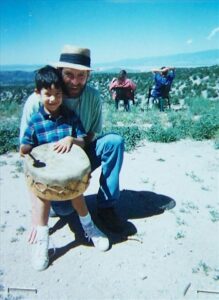
James and Gary at Earth Walks in Truchas, NM
As the group gathered, little James stood tall atop a green plastic chair facing the immensity of desert and mountains to the west. In his hands, stones were speaking through him to us, this weekend gathering of our Earth Walks vecinos–compadres y comadres, tios y tias–friends and family new and old.
James held a small stone in his young hands. “Now pass this stone from person to person,” James instructed. Stone passed, hearts opened, the breeze blew and the earth turned a bit more in its dance on this our second Earth Walks for people living with HIV, their care givers, friends and family. We camped out on the land, full moon sailing silently over the majestic Truchas peaks, some still white with winter snow, silently standing sentinel above us.
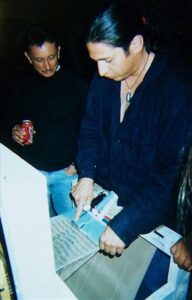
At the loom during Truchas, NM EarthWalks
“Just do the weaving and don’t think about it much,” Max advised, when the next day we all tried our hand at his looms, looms that over the years had created an abundance of beautiful tapestries. As I began to run the shuttle, mental distractions and random thoughts cris-crossed my mind. My shuttle got tangled in the threads like a fly in a web, and like the fly, my mind got tangled up too.
“Just keep it simple,” I told myself as I finally extracted the shuttle from the threads. This was a lot like other times in my life, trying to do too much in too little time. It seemed as if Grandmother Spider was telling me to slow down, have some patience and get my conscious mind out of the way of the creation. And I did. At least a little, enough to see some of what Max was talking about.
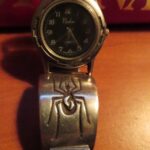
Hopi watchband with spider and friendship symbol
It didn’t dawn on me until 2017 while writing this story that there was an amazing pattern weaving itself all around me during the Earth Walks, like a spider web of balance and beauty. Just the day before our visit to the weaving studio in Truchas, my spider watch band arrived in the mail from Ross. Fortuitous timing, on a full moon summer solstice. I hadn’t made any payment to Ross. He simply sent it when it was finished in an act of trust and friendship.
That act of trust spiraled back 40 years to the trust a spider at the window and I had one lonely night during graduate school. All my web of relationships with spiders over the years has woven sacred strands of kinship between me and the natural world. I know now without a doubt if I get into a basement of loneliness again, I’ll be sure to have yoghurt on hand and look for one of God’s little eight-legged children.
 As I approached the summit of Puerto Nambe, I paused for air in the rarefied atmosphere and took in the great expanse nearly 12,000 feet below me. I felt small, insignificant amidst this vast panorama and yet somehow as wide and endless as the sky and its horizon. Far in the distance was Pedernal Peak on the northwest edge of the Jemez Mountain range.
As I approached the summit of Puerto Nambe, I paused for air in the rarefied atmosphere and took in the great expanse nearly 12,000 feet below me. I felt small, insignificant amidst this vast panorama and yet somehow as wide and endless as the sky and its horizon. Far in the distance was Pedernal Peak on the northwest edge of the Jemez Mountain range.






